 The proof that North and South America are not so far apart is in “The Americas,” a group show at the Esther M. Klein Gallery that includes 12 contemporary women artists born somewhere in the Americas and living in the U.S.–for the most part practicing art in New York.
The proof that North and South America are not so far apart is in “The Americas,” a group show at the Esther M. Klein Gallery that includes 12 contemporary women artists born somewhere in the Americas and living in the U.S.–for the most part practicing art in New York.
We’ve got artists from Canada to Chile and points inbetween, but it’s tough to tell who’s from where just by the art.
Video is a strong presence, as it is everywhere in the U.S.; we’ve got your encaustic and paint abstractions and your cartoony paint on canvas, your assemblage and fine drawing, your stitchery and computer prints, your plaster sculpture with flocking and the influence of English-language movies crossing the borders. A lot of the work had social and political subtexts.
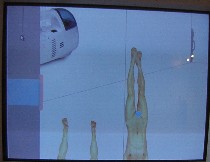 In Isabel Ron-Pedrique’s “Nadador” (Venezuela), a little naked man and woman with a cute blue dot strategically placed on each, swim through a world of sleek appliances and statistics about global spending and other wealth-related info. The swimmers, heading toward the top and the bottom of the screen as if they were doing laps, swim the breast stroke (thought you’d like to know; I was interested since I swim a lot) and look utterly vulnerable and human in the not so human world presented here. I tried playing with the mouse but didn’t get enough of a charge out of the change in the action to get excited about it (right, “Nadador”).
In Isabel Ron-Pedrique’s “Nadador” (Venezuela), a little naked man and woman with a cute blue dot strategically placed on each, swim through a world of sleek appliances and statistics about global spending and other wealth-related info. The swimmers, heading toward the top and the bottom of the screen as if they were doing laps, swim the breast stroke (thought you’d like to know; I was interested since I swim a lot) and look utterly vulnerable and human in the not so human world presented here. I tried playing with the mouse but didn’t get enough of a charge out of the change in the action to get excited about it (right, “Nadador”).
 Four videos were included: The high point for me was “Girls and Horses” by Eugenia Vargas (Chile) (left).
Four videos were included: The high point for me was “Girls and Horses” by Eugenia Vargas (Chile) (left).Vargas’ piece was a compendium of vintage movie footage from things like “National Velvet,” “How the West Was Won,” etc. etc. The sexual undertone and the money undertone came through loud and clear, as did the mythmaking–Anglophilia, the wild West, etc. I watched it twice (a good sign).
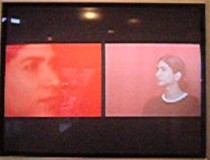 “Perfect” (right) by Claudia Joskowicz (Bolivia) was a conversation between two young women, one married, one not, about marriage and their assumptions about marriage. The title, which drips with irony, refers to the spouse of the married woman. The dialog comes down on neither side, but it raises questions about the value of marriage and the honesty of girltalk. There’s a bad titular translation as well as a more coherent dubbed translation of the movie, and at first I thought the point might be for the awkward titles to show up the lies in the conversation, but ultimately I decided that the titles were just bad, from a previous attempt to make the movie accessible to English speakers. But I don’t have the facts, so I do not really know for sure.
“Perfect” (right) by Claudia Joskowicz (Bolivia) was a conversation between two young women, one married, one not, about marriage and their assumptions about marriage. The title, which drips with irony, refers to the spouse of the married woman. The dialog comes down on neither side, but it raises questions about the value of marriage and the honesty of girltalk. There’s a bad titular translation as well as a more coherent dubbed translation of the movie, and at first I thought the point might be for the awkward titles to show up the lies in the conversation, but ultimately I decided that the titles were just bad, from a previous attempt to make the movie accessible to English speakers. But I don’t have the facts, so I do not really know for sure.
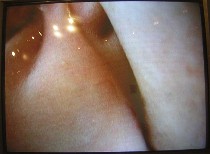 Karin Schneider (Brazil) presented “Pregnancy Outside the Womb” (left), a nursing baby up so close that for some of the video it looks like sexy body parts, which I found creepy. I also wasn’t crazy about the concept although I felt some sympathy for the mom, because there’s truth there. And Jillian McDonald (Canada) offered “Beavers for Cherries,” a two-channel video on mini screens that mixed sex and politics and nature, raising all kinds of issues but not so coherently (at least for me). (We recently wrote about McDonald’s “Me and Billy Bob” here.
Karin Schneider (Brazil) presented “Pregnancy Outside the Womb” (left), a nursing baby up so close that for some of the video it looks like sexy body parts, which I found creepy. I also wasn’t crazy about the concept although I felt some sympathy for the mom, because there’s truth there. And Jillian McDonald (Canada) offered “Beavers for Cherries,” a two-channel video on mini screens that mixed sex and politics and nature, raising all kinds of issues but not so coherently (at least for me). (We recently wrote about McDonald’s “Me and Billy Bob” here.
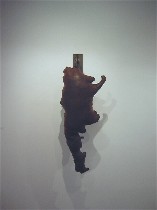 Politics comes through loud and clear in the stuffed and stitched, reimagined maps merging pieces of the Americas from Tamara Kostianovsky (Argentina), made from the artist’s clothes (right).
Politics comes through loud and clear in the stuffed and stitched, reimagined maps merging pieces of the Americas from Tamara Kostianovsky (Argentina), made from the artist’s clothes (right).
 Almost every piece had a piece with which to compare it. For instance Kostianovsky’s pillowy maps were next to Marisa Telleria-Diaz’s “a felix…” (left), two sweet but hard-as-rocks pillows almost on the floor, made of hydrocal, the hem looking like it was dipped in acrylic paint in a wonderful shade of pale blue, the two pillows resting on flocked pedestals. This pristine piece, about finding happiness (or is Felix a name?) in sharing a bed and in this context perhaps the Americas being in bed together, stood in stark contrast to Kostianovsky’s funky political maps.
Almost every piece had a piece with which to compare it. For instance Kostianovsky’s pillowy maps were next to Marisa Telleria-Diaz’s “a felix…” (left), two sweet but hard-as-rocks pillows almost on the floor, made of hydrocal, the hem looking like it was dipped in acrylic paint in a wonderful shade of pale blue, the two pillows resting on flocked pedestals. This pristine piece, about finding happiness (or is Felix a name?) in sharing a bed and in this context perhaps the Americas being in bed together, stood in stark contrast to Kostianovsky’s funky political maps.
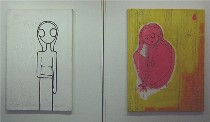 The cartoony faces in the two Emily Keyishian (U.S.) cartoons, “Hope & Pinky” (right), take back cartooning into a female realm and also seem like an attempt to be a feminist antidote to Keane. The surfaces scratched with writing give these paintings visual interest.
The cartoony faces in the two Emily Keyishian (U.S.) cartoons, “Hope & Pinky” (right), take back cartooning into a female realm and also seem like an attempt to be a feminist antidote to Keane. The surfaces scratched with writing give these paintings visual interest.
Although Venezuelan Patricia Cazorla names her piece “Vanessa” from her “Munecas (Dolls) Series,” Vanessa is anything but a doll and stands in stark contrast to Keyishian’s pieces (“Vanessa” image at top of post).
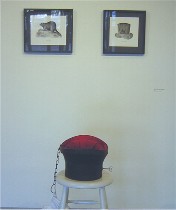 And next to Mcdonald’s “Beavers for Cherries,” the arrangement from Kelly Heaton (U.S.) of two beautiful drawings of beavers and top hat perched on a stool, holding a beaver trap is a scary indictment of marriage, I suppose. One of the drawings has the beaver compressed onto the crown of a drawn top hat, the other the beaver “in habit.” The title is something borrowed, “The Bride Stripped Bare of her Bachelor, Even, and Formal Transformations.” I’m unclear if this piece is also about trapping animals, not just trapping wives.
And next to Mcdonald’s “Beavers for Cherries,” the arrangement from Kelly Heaton (U.S.) of two beautiful drawings of beavers and top hat perched on a stool, holding a beaver trap is a scary indictment of marriage, I suppose. One of the drawings has the beaver compressed onto the crown of a drawn top hat, the other the beaver “in habit.” The title is something borrowed, “The Bride Stripped Bare of her Bachelor, Even, and Formal Transformations.” I’m unclear if this piece is also about trapping animals, not just trapping wives.
 Also showing were “Olas y Arenas” (right) digital prints of film stills on canvas by Aixa Requena (Puerto Rico) of bodies emerging from (or sinking back into?) sand and water, with tractor feeds suggesting film and motion and serials, and from Grimanesa Amoros (Peru), “La Piel,” encaustic evocations of skin and landscape (like that of Mars, perhaps).
Also showing were “Olas y Arenas” (right) digital prints of film stills on canvas by Aixa Requena (Puerto Rico) of bodies emerging from (or sinking back into?) sand and water, with tractor feeds suggesting film and motion and serials, and from Grimanesa Amoros (Peru), “La Piel,” encaustic evocations of skin and landscape (like that of Mars, perhaps).
I have to figure that a show with so much political work in it would ordinarily be more heavy handed; this show had its leaden, didactic moments, but all in all it was interesting. The show, nicely curated by Yucef Merhi, first opened in 2004 at the Galeria Galou in Brooklyn. This is its final destination.









